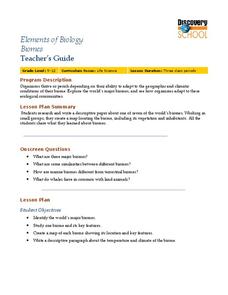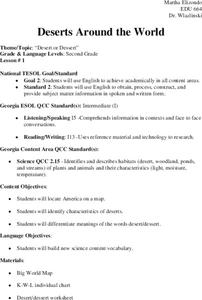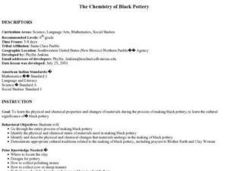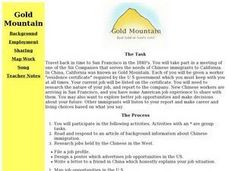Curated OER
Utah History & Geography
Fourth graders calculate and determine the distances between counties in Utah. Using a map of Utah, they determine the distance between three county seats, the total distance round trip, and label a map with the distances.
Curated OER
An Ancient Greek and Roman Festival
Third graders label a map of ancient Greek and Roman civilizations and do a written report on one element of these two cultures. They participate in discussions of food, farming, daily life and government (among others). Students use the...
Curated OER
Failing Ecosystems: Haiti and the Caribbean
Ninth graders study the impact that climate has on the land. They discuss how deforestation leads to erosion and soil damage and how trees and vegetation help to stabilize the land. They draw a large map of the Caribbean and show Haiti...
Curated OER
Why Does Delaware Have Such A StrangeShape?
Students examine the events and history surrounding the boundaries of Delaware. They participate in a class discussion and analyze a map, then create a floor map using masking tape. Students also participate in a play about the...
Curated OER
Community Arts Projects
Youngsters learn about community through exploration of their own neighborhood.In this lesson about community, students create a community in their classroom. Students think about what their community looks like by making a map. Students...
Curated OER
Biomes
Students explore the worlds biomes and see how organisms adapt to these ecological communities. In this world's biomes lesson students research and write a paper about one of the world's biomes.
Curated OER
Philanthropy and You
Students identify human rights and study the values of historical figures who fought for human rights. In this human rights instructional activity, students define the term human rights and research examples of human mistreatment in...
Curated OER
Charles Lindberghs's Flight to Paris
Young scholars practice map skills. In this map skills instructional activity, students locate the cities of New York and Paris on a map. Young scholars read about the flight made by Charles Lindbergh in May 1927 from New York to Paris....
Curated OER
Deserts Around the World
Second graders explore the deserts around the world. They use a map and locate America on the map. Students discuss and identify the characteristics of deserts and differentiate the meanings of the word desert and dessert. Students...
Curated OER
The Chemistry of Black Pottery
Sixth graders create pottery out of black clay using traditional methods. They demonstrate appropriate Native American cultural traditions related to the making of black pottery, including prayers to Mother Earth and Clay Woman.
Curated OER
New England Colonies
Students study the New England colonies. In this colonies lesson, students use a directed reading-thinking method to learn about the New England colonies. Students follow the method to make predictions, read the text, and analyze the...
Curated OER
Podcasting Crusader's Style
Students work as a group of scientists studying a specific biome of their choice. In this biome lesson, students research a biome and develop a podcast where factual information is read about a biome and the events of...
Curated OER
Controlling the Flow of the Colorado River: A Study of Dams
Students research and map the Colorado River and its dams and predict the effects of a dam on an area. They suggest reasons a dam would be built and compare the Colorado River system with other major river systems within the US and...
Curated OER
Bountiful Biomes
Students research five different biomes while working in groups. They complete a graphic organizer with the information.
Curated OER
Nuclear Waste
Students identify pros and cons of nuclear power, and analyze problems surrounding nuclear waste and how to make decisions regarding its disposal.
Curated OER
Elevation at its Peak
High schoolers pretend they are hiking up a mountain. They practice making calculations on angles and elevation. They use topographic maps to estimate distances and trigonometric ratio methods.
Curated OER
Gold Mountain: Real Gold or Fool's Gold
Students participate in a meeting of one of the Six Companies that serves the needs of Chineese immigrants to California in the 1840's. Jobs are researched, profiles filed, posters designed, Chinese immigrant life examined in this lesson.
Curated OER
How Can We Keep Our Forests Intact and Have Our Chocolate Too?
Fourth graders explore various methods of growing and harvesting rainforest foods in order to sustain its biodiversity. They discuss the various uses for trees from several viewpoints. Students research chocolate demand and land use...
Curated OER
Non-Fiction Animal Picture Books
Young scholars complete a multi-lesson unit using research to create their own book about an animal of their choice. After discussing the elements of non-fiction texts, they use internet research to explore an animal of interest to...
Curated OER
The Early History of Haiti
Seventh graders make list of places Columbus explored on his first journey to Americas, locate island of Hispaniola on map, examine groups of people who have inhabited island, complete blank map and key of Hispaniola, and research early...
Curated OER
Literary Tour of California via Podcast
Students explore California's authors and their lives. In this author study, students research different authors from California. They create podcasts about their authors, walking the audience through the author's life and points of...
Curated OER
Wolves
Learners utilize several different sources to research wolves, after completing the K-W-L process.
Curated OER
World War II Review
Ninth graders review previously presented material on World War II and discover how the world was at that time. They, in groups, participate in map work designed to explain Axis and Allied countries using toy army men.
Curated OER
Geography of Japan
Pupils complete a worksheet that guides them through an overview of Japanese geography. Students research the topography, climate, population and size of Japan and consider how these factors work together to produce Japanese culture.























